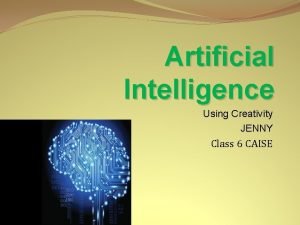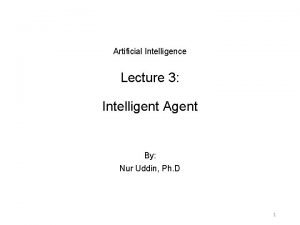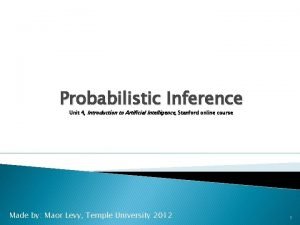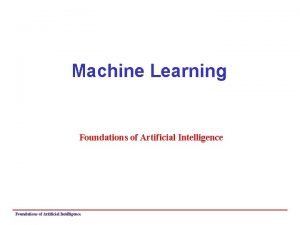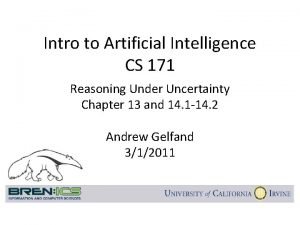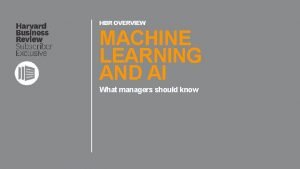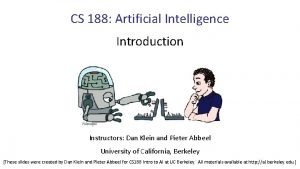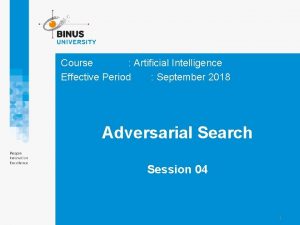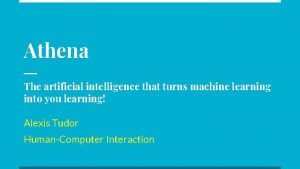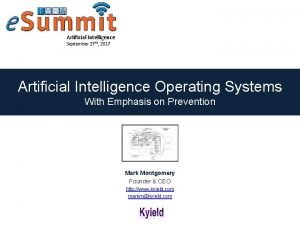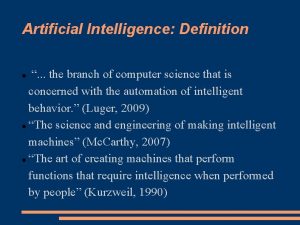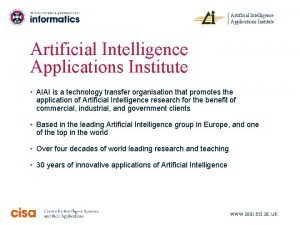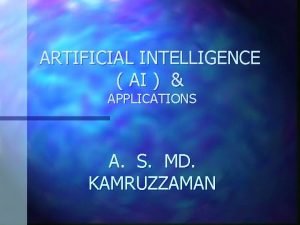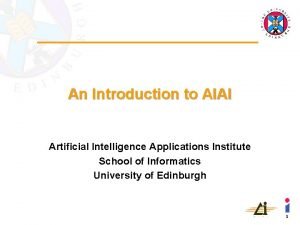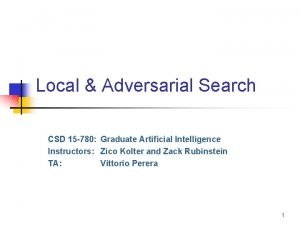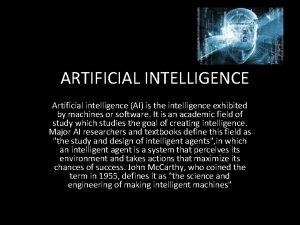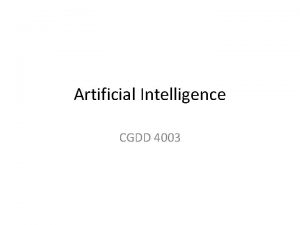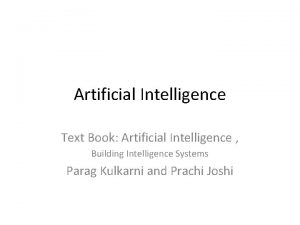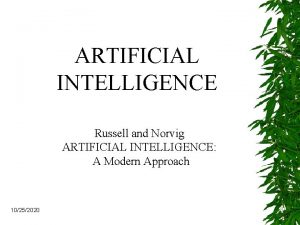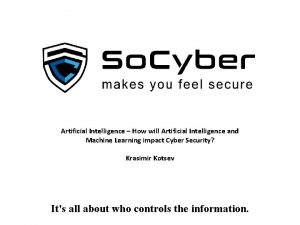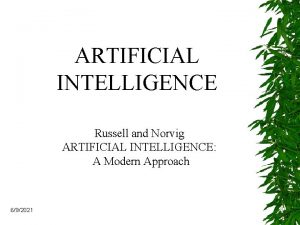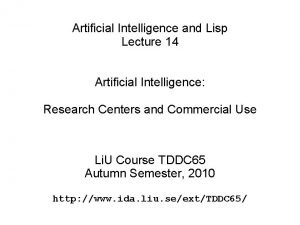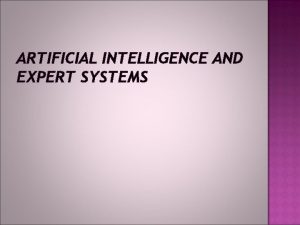ARTIFICIAL INTELLIGENCE WHATS NOW WHATS NEW AND WHATS











































- Slides: 43

ARTIFICIAL INTELLIGENCE: WHAT'S NOW, WHAT'S NEW AND WHAT'S NEXT Direct source from: e. Marketer. ‘ARTIFICIAL INTELLIGENCE WHAT'S NOW, WHAT'S NEW AND WHAT'S NEXT’. e. Marketer Report. url: https: //www. kictanet. or. ke/wpcontent/uploads/2017/05/e. Marketer_Report_Artificial_Int elligence_Now_Next. pdf

WHAT EXACTLY IS AI? + AI terminology usually describes – specific branches of computer science that deal with emulating human intelligence, + [There are] discrete types of AI exist for classification purposes, [but] – many business solutions actually involve more than one type, new AI technologies may be hybrids of several types and – many companies have different names for similar types of systems.

MAJOR AI TECHNOLOGIES (1) + Machine learning (ML)機器學習. – The branch of AI computing that involves training algorithms to perform tasks by learning from previous data and examples rather than explicit commands programmed by humans. + three of the most common algorithms are: – neural networks, induction algorithms and genetic algorithms. + Many applications of AI, such as: – computer vision and natural language processing, rely heavily on machine learning.

MAJOR AI TECHNOLOGIES (2) + ML: Neural networks. – Machine learning algorithms and computational – – models designed to function like neurons in the human brain. Neural networks are trained with specific sets of data points, which they use to guess at an answer to a query. The network’s guess is then compared with the correct answer for each data point. If errors occur, the “neurons” are tweaked and the process repeats itself until the error levels decrease. This algorithmic approach, called backpropagation, is similar to statistical regression.

MAJOR AI TECHNOLOGIES (3) + ML: Genetic algorithms. – Machine learning optimization algorithms that work by mimicking the evolutionary process using natural selection, recombination and mutation. – They are particularly effective at optimizing problems with a large number of possible solutions.

MAJOR AI TECHNOLOGIES (4) + ML: Induction algorithms. – Machine learning algorithms that learn by example and attempt to find patterns in data and create rules that explain what is happening. – The process of deduction, which involves a preset collection of rules, these algorithms create rules to explain things that are happening on the fly.

MAJOR AI TECHNOLOGIES (5) + Deep learning 深度學習. – A branch of machine learning concerned with building and training neural networks with multiple layers. – Each layer of a network can find patterns in the output of the layer above it. – Deep networks shine at sorting and classifying data and identifying anomalies in data patterns.

MAJOR AI TECHNOLOGIES (6) + Expert systems. – Also known as knowledge representation systems or decision support systems. – are an older form of AI technology that was originally designed to solve complex problems by making decisions based on a knowledge base and rules for applying that knowledge. – Newer machine learning models [i. e. with more sophisticated, data-driven and statistical approaches] can now make more effective decisions than expert systems.

MAJOR AI TECHNOLOGIES (7) + Knowledge representation. – A branch of AI that involves the representation of different types of information in ways that computer systems can use to perform complex tasks or solve problems.

COMMON APPLICATIONS OF AI (1) + Many of today’s commercial applications are built on: – Computer vision. Also called machine vision. Ï Ï The branch of AI that deals with how computers emulate the human visual system and their ability to view and interpret digital images from the real world. It also incorporates image processing, pattern recognition and image understanding (turning images into descriptions that can be used in other applications).

COMMON APPLICATIONS OF AI (2) + Machine translation. – A form of automated translation by which computer software is used to translate text or speech from one natural language to another (e. g. , from Russian to English). – … it can incorporate statistical techniques that increase the likelihood of correctly identifying phrases, idioms, proper names and other anomalies.

COMMON APPLICATIONS OF AI (3) + Natural language processing. – A branch of AI that deals with a machine’s ability to understand spoken or printed words in human (natural) languages, as opposed to computer programming languages. – These technologies are heavily used by search engines, for spam filtering and for their ability to extract information from large and complex documents.

COMMON APPLICATIONS OF AI (4) + Natural language generation. – A subset of natural language processing in which a computer makes decisions about how to make sense of a specific concept and put it into words. – It can also dynamically create communications— including basic news articles and real estate listings—that meet specific goals.

COMMON APPLICATIONS OF AI (5) + Computational linguistics. – An interdisciplinary field that concerns itself with statistical and rule-based modeling of natural language data by computers. – It includes speech/voice recognition, the process by which machines can identify and recognize spoken words and phrases and translate or convert them to machine-readable text.

COMMON APPLICATIONS OF AI (6) + Chatbot. – A computer program that uses a set of rules to conduct a speech- or text-based conversation with a human over an online chat interface. – Chatbots are increasingly powered by AI and use machine learning to detect and mimic human conversation. – They are commonly developed to provide specific content or automated service or utility to users.

COMMON APPLICATIONS OF AI (7) + Virtual digital assistant. – A more sophisticated version of a chatbot, also known as an intelligent agent, virtual personal assistant, virtual intelligent assistant, automated assistant or virtual agent. – Such assistants can organize, store and output information based on the user’s location and can answer voice or text-based queries from the user with information from a multitude of online sources (e. g. , weather forecasts, maps, stock prices or transportation schedules). – Examples include Apple’s Siri, Google Now, Amazon’s Alexa and Microsoft’s Cortana.

COMMON APPLICATIONS OF AI (8) + Recommender systems. – Also known as recommendation engines. – An AI-driven information filtering system that can automatically predict user preferences and responses to queries based on past behavior, one user’s relationship to other users, similarity among items being compared and context. – High-profile examples of recommender systems include Amazon’s “frequently bought together” feature and Netflix’s Cine. Match algorithm. – Similar algorithms are also used by social networks such as Facebook, Linked. In and Ancestry. com to Ï find connections among people and data and to identify targets for marketing campaigns.

COMMON APPLICATIONS OF AI (9) + Predictive analytics. – Programs that use a combination of techniques from data science, statistics and artificial intelligence to analyze sets of structured and unstructured data, uncover patterns and relationships, and use them to make predictions about probable future outcomes and events. – Predictive analytics models are closely related to prescriptive analytics models, which incorporate a predictive model but go a step further to produce actionable data and use and a feedback system that tracks outcomes.

OTHER NAMES FOR AI (1) + “Artificial intelligence” or “machine learning” - are often used in place of or interchangeably – These are not official branches of computer science but instead …. – … created by marketers to help describe and commercialize different types of AI technology.

OTHER NAMES FOR AI (2) + Cognitive computing. – This is a catchall term popularized by IBM to describe the process by which machines can mine data, recognize patterns and process natural language to interact and emulate human intelligence. – …. the term refers to computers that can simulate human thought processes. – IBM and other organizations often use this term instead of the broader term “artificial intelligence. ”

OTHER NAMES FOR AI (3) + Augmented intelligence. – Also known as cognitive augmentation or intelligence amplification. – Another catchall, it refers to technology designed to use the combined strengths of human and machine intelligence. – Some of the large players in the field of AI prefer this term to describe their offerings to minimize perceptions that machines will eventually take over human work. – “At IBM, we are creating ‘augmented intelligence, ’ not ‘artificial intelligence, ’” said Nish Parekh, program director of Watson client services at IBM. – “It’s the important difference between systems that enhance and scale human expertise and those that attempt to replicate human intelligence. ”

OTHER NAMES FOR AI (4) + Man-machine learning. – Conceptually similar to augmented intelligence, this is often used to describe AI that combines human guidance with machine analysis of large volumes of data. – The term was developed in part to reassure audiences that human effort is still needed to provide reinforcement and feedback to the machine, which then refines its algorithm to achieve the desired results.

MARKET FORECASTS DIFFER, BUT THEY ALL INCLUDE GROWTH + the largest share of the AI market – media and advertising industry … specifically with the goal of analyzing consumer behavior to “influence their buying pattern. ” + Machine learning technology was by far the most dominant in – the worldwide AI market + the market for natural language processing technology – has significant growth potential in media and advertising, retail, finance and other areas—was expected to grow at the highest rate.

DRIVERS OF AI ADOPTION (1) + The internet of things (Io. T). – Many industry watchers see the internet of things as key to pushing AI along, in large part because – Artificial intelligence has significant potential in powering Io. T solutions and in crunching the massive volumes of data the Io. T is already starting to provide.

DRIVERS OF AI ADOPTION (2) + Data overload. – The avalanche of data from computers, mobile devices, Io. T sensors and other connected things has become overwhelming and not humanly manageable. – According to IBM’s website, the world creates approximately 2. 5 quintillion bytes of data each day, and – “ 90% of the data in the world today has been created in the last two years alone. ” – Many businesses are turning to AI solutions to help them make sense of this data and to use it in new ways.

DRIVERS OF AI ADOPTION (3) + Tech giants with deep pockets. – Many of the world’s major tech companies— including IBM, Google/Deep. Mind, Microsoft, Facebook, Samsung, Amazon, Salesforce and Alibaba—operate their own development labs and have rolled out commercial services to bring AI technology to the masses. – For example, IBM Watson, Microsoft Azure, Amazon and Alibaba each launched turnkey, cloud -based machine learning software-as-a service (Saa. S) solutions in 2015.

DRIVERS OF AI ADOPTION (4) + Innovative startups. – These companies are developing a rich pipeline of niche AI technologies for specific business problems,

DRIVERS OF AI ADOPTION (5) + A collaborative academic community. – Data scientists and AI researchers at big tech companies, startups, universities and private research consortia are increasingly coming together to advance AI technology for the common good. – They have developed common standards and libraries of open-source material. – This means smaller companies seeking to dip their toes into the AI waters need not write their own algorithms or recreate the wheel.

DRIVERS OF AI ADOPTION (6) + Successful use cases. – As AI continues to produce results, it is attracting the attention of more and more business decisionmakers.

A CROWDED MARKET, WITH A FEW ON TOP (1) + Most of today’s large-scale AI development is being spearheaded by the world’s tech giants. Here are some of the heavy hitters: + IBM. – IBM’s Watson supercomputer—which is based on natural language processing, machine learning and reasoning algorithms and can extract meaning from images, videos, text and speech— Ï became one of the most visible and famous examples of AI when it beat two of the best-ever “Jeopardy!” players on the TV game show in 2011. Since then, IBM has created about 100 commercialized products, apps and services built on Watson. – In 2015, IBM announced its Cognitive Business Solutions Unit, an internal consulting organization working to tailor the company’s data and cognitive technologies to a wide variety of industries and business needs. – According to IBM’s Parekh, solutions are being built, used and deployed in more than 45 countries and across 20 different industries.

A CROWDED MARKET, WITH A FEW ON TOP (2) + Google. + Over the past decade, Google, with its Deep. Mind unit, has become one of the heavyweights in AI. + Since 2015, the company has incorporated deep learning technology called Rank. Brain into its search engine to help it understand respond to some queries more effectively. + Machine learning underpins its driverless car technology and in early 2016 its Watson-like machine, Alpha. Go, beat world champion Lee Sudol in Go, the highly complex and strategic board game that originated in China. + Google also offers its own version of an automated virtual assistant, Google Now, a chat app (Allo), an upcoming speaker-like device called Google Home and Tensor. Flow, an open-source machine learning software library.

A CROWDED MARKET, WITH A FEW ON TOP (3) + Apple. – Apple’s most well-known AI initiative is Siri, the intelligent personal assistant that runs on i. Phones, i. Pads and the most recent version of its desktop operating system. – But the company also has a host of other behind-the-scenes initiatives that help its products and services recommend content, recognize faces, predict word choices, recognize usage patterns and improve device battery life. – In June 2016, Apple announced that its new operating systems would incorporate more AI features with predictive capabilities, such as scanning and organizing photos using facial recognition and grouping them together based on location.

A CROWDED MARKET, WITH A FEW ON TOP (4) + Facebook. – Compared with IBM and Google, Facebook arrived late to the AI party. But since then, it has been working aggressively to build out its machine learning and AI capabilities. – …. has used AI-based algorithms to recognize and tag faces in photographs, curate News Feeds and manage ad placements. – In June 2016, Facebook announced Deep. Text, a text understanding engine based on deep learning that it says can understand textual context of thousands of posts—in more than 20 different languages— per second. – “Deep. Text has the potential to further improve Facebook experiences by understanding posts better to extract intent, sentiment and entities (e. g. , people, places, events), using mixed content signals like text and images, and automating the removal of objectionable content like spam, ” Facebook said. – The company’s intelligent agent, M, part of Facebook Messenger and now in beta testing, can communicate via text with users and perform a number of customer service functions like booking travel arrangements and ordering flowers. Future projects are expected to include recognizing individuals by their voices from within videos.

A CROWDED MARKET, WITH A FEW ON TOP (5) + Microsoft. – Microsoft has been experimenting with neural networks and deep learning for many years and has recently made a number of acquisitions, including Swift. Key, a keyboard app that analyzes users’ typing history and learns their usage patterns. – Several years ago, Microsoft produced one of its most important breakthroughs, Skype Translator, which uses voice recognition to translate speech and text in real time. – Microsoft also offers the Cortana Intelligence Suite, based on its digital personal assistant, Cortana; – Microsoft Cognitive Services, which help developers use AI technology in their applications by adding simple code; and – its Azure cloud computing platform and toolkits for machine learning and to help developers create intelligent bots based on Skype’s text, voice, video and 3 -D communication capabilities.

A CROWDED MARKET, WITH A FEW ON TOP (6) + Samsung’s “smart devices” initiative, the fourth-largest investor in global AI companies wants to push further into the software business and marry AI technology with the hardware it already makes for – – phones, consumer electronics, appliances and cars.

A CROWDED MARKET, WITH A FEW ON TOP (7) + Salesforce. – The world’s fourth-largest enterprise software company has been on an AI startup acquisition spree over the past two years. – Its most recent acquisition, Meta. Mind, develops Ï Ï Ï natural language processing, computer vision and predictive analytics tools. – Introducing Salesforce Einstein, a new AI platform, in September 2016. – Einstein integrates AI into the company’s sales, service and marketing platform and enables customers to build AI-powered apps.

A CROWDED MARKET, WITH A FEW ON TOP (8) + Amazon. – The company has long used AI in its search function and recommendation engine, data scientists are working on more sophisticated demand forecasting models that predict Ï Ï how likely customers are to click on products shown in search queries, and how likely they are to click on related links and make purchases. – The company’s Amazon Echo home speaker system comes with an AI-powered virtual assistant, Alexa, that can Ï Ï recognize speech and answer general knowledge questions; read books, articles and other content; play music on demand; control smart-home devices; and order products.

A CROWDED MARKET, WITH A FEW ON TOP (9) + Alibaba. – The platform, called Aliyun, incorporates machine learning and deep learning algorithms that can help developers predict user behavior and build applications more quickly. – In August 2016, the firm’s cloud computing arm released a new suite of AI solutions, including video, image and speech recognition technologies that can be used in a variety of industries to increase efficiency, lower costs and monitor risks.

A CROWDED MARKET, WITH A FEW ON TOP (10) + Baidu. – Through its artificial intelligence lab in Silicon Valley and deep learning lab in China, the search giant has developed a variety of AI-powered initiatives that it is integrating into its core search and web services offerings. – Examples include image recognition, video analysis, augmented reality technology and medical image recognition. – It is also using developing technology for self-driving cars and using neural networks to find malware on its network and to target ads.

A CROWDED MARKET, WITH A FEW ON TOP (11) + The May 2015 Narrative Science survey found that 58% of US business executives polled were already using AI — particularly in conjunction with big data technologies. + Of those, nearly one-third (32%) said voice recognition and voice response solutions were the AI technologies they used most. + The study showed that organizations also used AI for machine learning (24%) and as virtual personal assistants (15%). + Smaller percentages cited decision support systems, automated written reporting and communications, analyticsfocused applications and robotics.

WHAT’S NEXT FOR AI? (1)

WHAT’S NEXT FOR AI? (2)

WHAT’S NEXT FOR AI? (3)
 Math and artificial intelligence
Math and artificial intelligence What is informed search and uninformed search
What is informed search and uninformed search Pxdes
Pxdes Mycin expert system architecture
Mycin expert system architecture Prolog iterative deepening search
Prolog iterative deepening search Searching for solutions in artificial intelligence
Searching for solutions in artificial intelligence 15-780 graduate artificial intelligence
15-780 graduate artificial intelligence Knowledge manipulation in ai
Knowledge manipulation in ai Procedural knowledge in ai
Procedural knowledge in ai American association for artificial intelligence 17 mar
American association for artificial intelligence 17 mar Kecerdasan kepemimpinan
Kecerdasan kepemimpinan Artificial intelligence assessment
Artificial intelligence assessment Peas description for interactive english tutor
Peas description for interactive english tutor 15-780 graduate artificial intelligence
15-780 graduate artificial intelligence Xkcd deep learning
Xkcd deep learning Fuzzy propositions examples
Fuzzy propositions examples Cse 571
Cse 571 15 780
15 780 What is artificial intelligence class 6
What is artificial intelligence class 6 Levels of language analysis
Levels of language analysis Omniscience in artificial intelligence
Omniscience in artificial intelligence What is the alan turing test
What is the alan turing test Searching for solutions in artificial intelligence
Searching for solutions in artificial intelligence Partitioned semantic network in artificial intelligence
Partitioned semantic network in artificial intelligence A* vs ao* algorithm
A* vs ao* algorithm Artificial intelligence thesis proposals
Artificial intelligence thesis proposals Rule based deduction system
Rule based deduction system Inference by enumeration in artificial intelligence
Inference by enumeration in artificial intelligence Learning in ai
Learning in ai Production rule for water jug problem
Production rule for water jug problem Optimal decisions in games in artificial intelligence
Optimal decisions in games in artificial intelligence Andrew ng hbr
Andrew ng hbr Cs188 artificial intelligence
Cs188 artificial intelligence Optimal decisions in games in artificial intelligence
Optimal decisions in games in artificial intelligence Athena machine learning
Athena machine learning Types of artificial intelligencel
Types of artificial intelligencel Inference in first-order logic
Inference in first-order logic Ai is a branch of computer science
Ai is a branch of computer science Mobedic
Mobedic Conclusion of artificial intelligence
Conclusion of artificial intelligence Artificial intelligence applications institute
Artificial intelligence applications institute Space complexity bfs
Space complexity bfs 15-780 graduate artificial intelligence
15-780 graduate artificial intelligence Ethics of artificial intelligence
Ethics of artificial intelligence


















